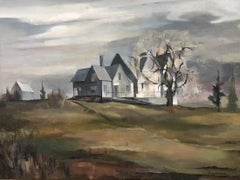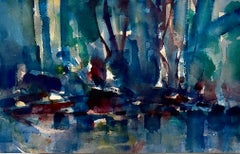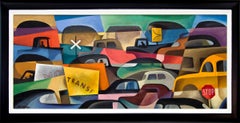'Abandoned (Colorado)' is an oil painting by William Sanderson (1905-1990) depicting an abandoned house in green grass hills. Presented in a custom frame measuring 13 ¼ x 16 ½ inches; image size measures 8 ½ x 11 ¼ inches.
Painting is in good condition - please contact us for a detailed condition report.
About the Artist:
Born Latvia 1905
Died Colorado 1990
The elder son of a construction engineer, he was born Wilhelm Tsiegelnitsky in a seaside resort near Riga, Latvia, then part of the Russian Empire. His father, Grigori Mojesevich (later Anglicized to Gregory) was of Russian-Jewish heritage, while his mother Berta (Bertha) came from a German-Jewish background. Because preference in awarding construction contracts at that time were being given to members of the Russian Orthodox Church, his father had the whole family baptized in that church which he kept a secret from Sanderson’s grandparents.
His father’s profession took the family to a number of cities in various parts of the Russian Empire including Warsaw, Kharkhov, Kiev, and Samarkand in Asia. To his mother’s annoyance, he scribbled on anything within easy reach, deciding by age ten that he would make art his lifetime goal. During the Bolshevik Revolution in 1917 the family lived with relatives in Rostov-on-the-Don where his mother enrolled him in the local Chinyenov Art School, marking the first step in his art career.
Feeling that they would have no place in the new Communist political reality, in 1921 the family left Rostov for Kiev, emigrating to Italy and Greece on short-term visas before arriving in New York two years later, sponsored by Gregory’s relatives in New Jersey. The Tsiegelnitsky surname was changed to the more pronounceable Siegel. Experiencing the frustration shared by most immigrants seeking to establish themselves in a new, unfamiliar environment, Sanderson sufficiently mastered English by 1924 to attend the Fawcett School of Industrial Art in Newark (later the Newark School of Fine and Industrial Art) where he studied with Ida Wells Stroud, herself a student of William Merritt Chase and Arthur Dow and part of the early twentieth-century Arts & Crafts Movement.
Seeking a more challenging curriculum, he enrolled at the National Academy of Design in Manhattan (1924-1927), studying painting with Charles Hawthorne, etching with William Auerbach-Levy, and life drawing with Charles L. Hinton. Sanderson won the Suydam Medal for Life Drawing, First Prize in Composition, and Honorable Mention in Etching. He also briefly attended the Art Students League in New York in 1928, studying lithography with Charles Locke who in 1936 taught a summer course in the medium at the Colorado Springs Fine Arts Center. However, Sanderson quit the League when he could no longer afford the tuition.
With his art studies behind him, he began a successful career in illustration in New York. Briefly associated with the Evening Graphic, he maintained a decade-long affiliation with the New Masses, honored to be in the company of such established artist-contributors as Jean Charlot, Stuart Davis, Adolf Dehn, Louis Lozowick, Reginald Marsh, Jan Matulka and Boardman Robinson – some of whom later were affiliated with the Colorado Springs Fine Arts Center in the 1930s and 1940s. As a young immigrant he came to share some of the popular views of the left-wing intellectual community in American in the 1920s and early 1930s; but in 1936 he severed his connections with the New Masses because he did not like the direction it had taken by that time.
In 1929, the year of the stock market crash and the onset of the Great Depression, he began doing commercial book illustration in New York which he continued until being drafted during World War II. However, his steady income disqualified him from participation in the Works Progress Administration (WPA)-era art projects. A barometer of his success was his inclusion in the Fifth Exhibition of American Book Illustration in 1935 sponsored by American Institute of Graphic Arts whose jurors included Edith Halpert of The Downtown Gallery in New York. Among the book titles he illustrated were: Marian Hurd McNeeley, The Jumping Off Place; P.N. Krasnoff, Yermak the Conqueror; Joe Lederer, Fanfan in China; Fay Orr, Freighter Holiday; and The Cavalcade of America. His images of a covered wagon and a Daniel Boone prototype in the last-named publication anticipate subjects he later explored more fully in his easel painting in Colorado with likenesses such as The Woman of the Plains and Hombre.
In the 1930s and early 1940s he also produced illustrations and covers for leading American magazines such as The New Yorker, Esquire, Cue, and Harper’s. In 1931 he became a naturalized U.S. citizen in Manhattan and by 1936 began informally using Sanderson as his surname, making the change official in 1941. In 1937 he was given a solo show at the American Contemporary Art (A.C.A.) Gallery in New York.
The following year he became art director at the McCue Ad Agency in New York where he worked until after the Japanese attack on Pearl Harbor. Looking forward to the day when he could give up illustration for the fine arts, his career change was set in motion when he was drafted into the U.S. Army in March 1942. After basic training at Kessler Field near Biloxi, Mississippi (where the Tuskegee Airmen also trained) he shipped out at his own request to Lowry Air Force Base in Denver, becoming part of the Army Air Corps and taking an instant liking to Colorado. At Lowry his humorous drawings of barracks life were published in the base newspaper, The Rev-Meter.
In the summer of 1943 he had his first solo exhibition in Colorado at the Denver Art Museum-Chappell House that consisted of black-and-white drawings of army life. He also began painting watercolor scenes from memory of his previous life in the East. His two visits to Vance Kirkland’s studio in Denver’s Capitol Hill neighborhood, while stationed at Lowry, occasioned a lifelong friendship and professional association. On Sanderson’s excursion in 1943 to the Colorado Springs Fine Arts Center he met his future wife, Ruth Lambertson from Cedar Falls, Iowa, whom he married eight weeks later, initiating a union lasting forty-seven years.
His fluency in Russian landed him an assignment as an interpreter with the American ground forces meeting up with the Soviet Army marching westward toward Berlin in the last months of World War II. His impressions and photos of the bombed-out city formed the basis of his montage, Berlin 1945, painted in Denver in 1947. Its palette and collage-like quality and that of some of his other paintings from this period reflect the influence of American modernist, Stuart Davis.
Following his military discharge and some brief design work for the Kistler Stationery Company and the A.B. Hirschfeld Press in Denver, Sanderson swapped commercial art for academia in 1946 when Vance Kirkland hired him as Assistant Professor of Advertising Design at the University of Denver, which subject he taught until retiring in 1972. Along with Kirkland and other faculty artists, he became a charter member of the 15 Colorado Artists. Founded in 1948, the group comprised some of the state’s leading contemporary artists seeking to distance themselves from much of the traditional imagery then being produced and exhibited in Denver and elsewhere. Reflecting the viewpoint of his fellow charter members Sanderson said, "I’m very taken with the nature scenes in this region, but it’s not the function of the artist to paint them when there are photographers around." Paraphrasing Picasso, the leading representative of contemporary art at that time, he added: "The painting is the artist’s representation of what nature is not."
The financial security and stability of his teaching position at the University of Denver (DU) gave him the freedom to develop his easel painting. He produced a large body of oils and watercolors in both stylized Realism and Surrealism depicting, respectively, Colorado-inspired subject matter and social criticism of modern life and industrial civilization. One of his first canvases, Steamship Ruth, titled in honor of his wife and incorporating elements remembered from the port of Rostov in Russia has large, precisely-arranged areas of flat color with crisp edges seen in many of his Colorado paintings in the 1950s and 1960s. Similarly, Mountain Rhythm employs a bright palette and undulating lines conveying his fascination with the overall composition of irregular mountain and cloud shapes.
Trailer Park, near the foothills west of Denver, provided abundant material for a geometric form study, while Composition with Fried Eggs in the Denver Art Museum’s collection essentially is a semi-cubistic arrangement of interlocking planes and spaces that was reproduced in the August 25, 1952, issue of Time Magazine. His work was also shown in group exhibitions outside Colorado at the Dallas Fine Art Museum, Museum of New Mexico (now, New Mexico Museum of Art) in Santa Fe, Joslyn Memorial Museum in Omaha, San Francisco Art Association, Salt Lake City Art Center, and the Cedar City Art Museum Association in Utah. The positive notice accorded his work in the early 1950s earned him a commission from the Ford Motor Company to illustrate an article, Fort Garland, by Marshall Sprague in the June 1954 issue of Ford Times. (Similar commissions were also given at that time to Denver’s Vance Kirkland and Richard Sorby.)
In the mid-1950s Sanderson also executed several murals in different techniques for secular and religious buildings in Colorado, reminiscent of artists’ commissions under the Federal Arts Projects (FAP) during the Depression era: the Graland School lobby and the Colorado Tobacco Building, both in Denver; St. Joseph’s School, Salida; Mesa Elementary School, Cortez; as well as the Andrew Jackson Hotel in Nashville, Tennessee.
Sanderson’s life in Europe and illustration work for the New Masses in New York made him very aware of ethnic and racial prejudice. He said, "I believe the artist is first of all a human being with the ability to see and depict the hope, aspirations and the despair of other human beings." In the 1950s he recorded the political movement for Black racial equality in paintings such as Noon Hour,
Whites Only...




